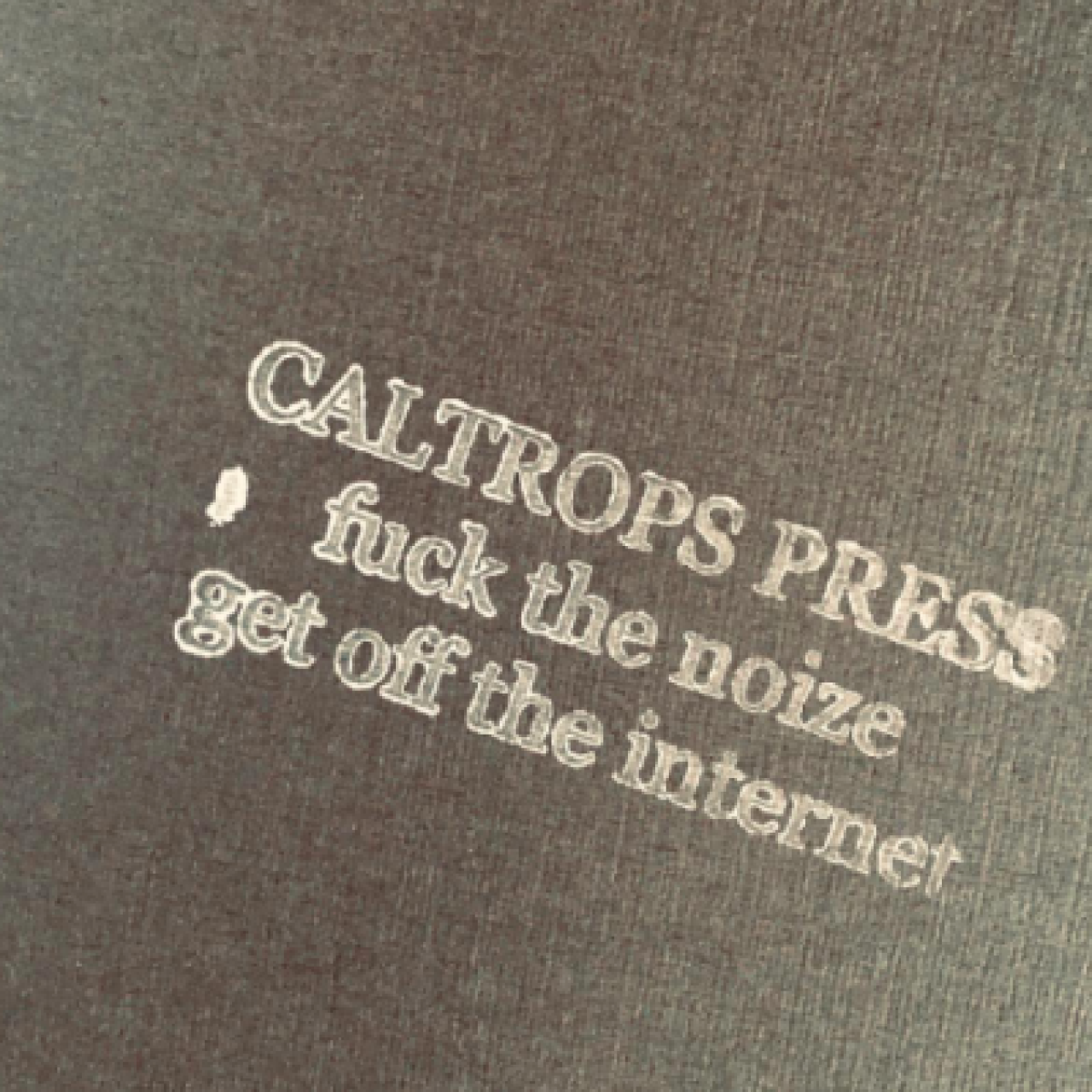New Jersey author Joseph Rathgeber has published Caltrops since June 2021. Far from a catalog of personalities, gossip, and record reviews, the small print zine, which usually spans between 24 and 36 pages and has published 13 issues to date, serves as a showcase for esoteric music analysis, where albums become entry points into a lexicon of cultural references. (He also publishes Caltrops pieces on a Tumblr site.) It has become an key artifact of the ongoing underground rap renaissance.
Issue 12, for example, spotlights billy woods’ and Kenny Segal’s Maps with a lengthy essay that namedrops De La Soul’s Trugoy the Dove, German author Rainer Marie Rilke, British author Joseph Conrad, and Aesop Rock in the introduction alone. Some of Rathgeber’s reference points seem like delightful flights of fancy, as when he compares woods’ complaints about having to do another concert tour to V.S. Naipaul’s The Mimic Men. Others feel deeply incisive. In response to woods’ joke on “Kenwood Speakers” about boring his dinner hosts to death, Rathgeber writes, “He’s Claudius with a cup of poison. The whole ear of gentrified Bed-Stuy serpent-stung, rankly (and thankfully) abused.” He goes on to write, “woods reveals himself to be Samwell Tarly with the black dragonglass dagger.” Rathgeber makes little distinction between high and low culture, and between Shakespeare’s Hamlet and the Tarly character from HBO serial Game of Thrones. They’re all part of a wellspring inspired by his encounters with the music.
Rathgeber distributes Caltrops for free through email and his social media accounts, including Instagram. He also gives them away during concerts he attends on the East Coast, and back issues can be found for purchase at a small number of record stores. In addition to producing Caltrops, Rathgeber is a 2016 creative writing fellow of the National Endowment for the Arts, and he won a fellowship from the New Jersey State Council on the Arts for poetry in 2014 and 2023. He has published a novel (Mixedbloods) and a short story collection (Bad Days on the Batsto: Stories), among other works.
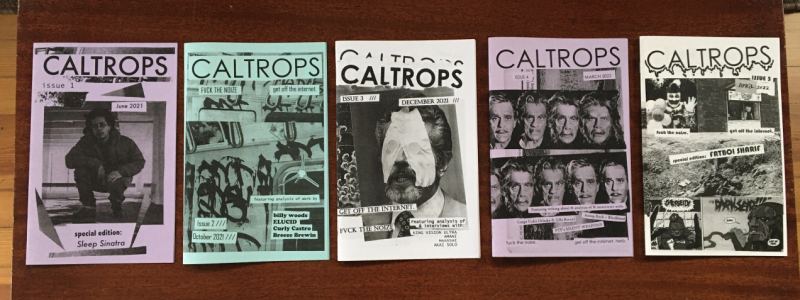
While doing research, I found plenty of information on your literary work, but not as much on your music writing. Have you written about music for any outlets, perhaps under an alias?
I’ve only ever written about music for Tiny Mix Tapes, and, yes, it was under an alias, which is probably for the best. Not sure how many of those reviews I would still vouch for today. I wrote for TMT from around 2002 until 2010, though my contributions were pretty sporadic in those last few years. I’m proud to have been a contributor there. TMT kind of presented itself as a foil to Pitchfork. They were equal-parts irreverence and avant-garde, not to suggest those are mutually exclusive. We’d go out of our way to engage in punkish stunts like stealing Pitchfork’s content on April Fools’ Day. We had a political consciousness, a radical one. I recall a spirited behind-the-scenes discussion when it became clear that the cost of keeping the site up and running would require permitting banner ads. So many excellent writers came out of there. (Samuel Diamond comes to mind — one of the few writers who really pulled for ELUCID and woods in the early days before anybody else gave notice.) We were allowed and encouraged to be adventurous, both in our writing and the music we explored. A real freeform aesthetic and scene. Marvin Lin (Mr P), the editor-in-chief, would shuck promo CDs from their jewel cases and send me a pile of discs wrapped in rubber bands and one-sheets. He’d ship them media mail, and this brick-sized, tattered package would arrive looking like a Kaczynski job. I fondly remember spreading the bounty on my floor and deciding what albums I wanted to write about. Lots of people — readers and artists alike — speak very highly of what TMT was and what it represented, so I’m lucky for that to have been the one music publication I was a part of.
Early issues of Caltrops featured pieces in a range of formats and lengths. But you’ve since focused on explications of albums. What inspired you to develop the latter?
Mostly because I’ve been encountering albums that I think warrant the full treatment. The first was [billy woods’] Aethiopes, which was so tight thematically that it all but required that sort of attention. The same could be said for [ELUCID’s] I Told Bessie, [woods’] Church, Maps, and, to a lesser extent, [Fatboi Sharif & No Face’s] Preaching in Havana. These artists, you can tell, conceive of solo projects as something to be taken in total. I want Caltrops to remain fluid in format though, so I don’t intend to stick with these longer issues unless inspiration strikes. Recently, I’ve rattled off three pieces that clock in around 2000-words, each focusing on a single song. That’s what I originally conceived Caltrops to be. Easier to fit multiple pieces in a zine that way. But I’ve also enjoyed creating these issues (call them “special,” if you wish) devoted to entire albums.
Some of your pieces are not only quite long — “An Itinerary for Non-Places: billy woods & Kenny Segal’s Maps” is over 15,000 words — but also dense with literary, artistic, musical, and cultural allusions. How long does it take you to write these essays?
Usually between one and two months for those album-length pieces. That reflects me pushing all other writing projects to the side. One of the great things about Caltrops is it’s just me — writer, editor, zine-maker, promoter — so I don’t work under any deadlines. That said, I can be an authoritarian and discipline myself with self-imposed deadlines — probably due to an outside pressure, a “buzz” surrounding a project. In those cases, I’ll work with a sense of urgency. I’ve learned there’s a listenership out there which doubles as a readership. People have been such gracious and loyal readers. They’ll message me and say, “Can’t wait to hear what you have to say about this one.” That compels me to put my nose to the grindstone. Backwoodz Studioz doesn’t send me promos ahead of time (cough), so from the date of the drop until the date of when I publish on the website is how long it takes me. As you note, the variety of allusions and considerable references I make to other work is time-consuming. With Aethiopes, for example, I had a stack of books plucked from my library that I drew from. Though the process can be a bit maddening, I’d be lying if I said I didn’t enjoy immersing myself in it.
Do you keep track of how many copies you distribute? I remember requesting issue 9, which features “A Catechism for billy woods’ Church.” You responded its original heavy-stock cover wasn’t available, and that you could only send a second edition, which has Xeroxed paper covers.
I’ve been inconsistent with keeping track. I hand-numbered the first 100 copies for the Church and Maps issues, and continued to add to that count once I exceeded 100 (so, 101/100, 102/100…), but I typically lose track in the rush and shuffle of packing envelopes and ultimately abandon the tally (Somehow he fucked up the count, like woods says on “Vindaloo”). I was doing that numbering in the spirit of art prints or tour-only CD-Rs that musicians would sell back in the day. After the initial cardstock runs on special issues, I xerox copies on regular printing paper, which is more in line with the traditional zine aesthetic anyway. And I keep the OG, master document of each issue in an individual manila folder, so I can always run off additional copies, if needed. It’s not uncommon for somebody to reach out and say, Hey, I missed issue 2, or Do you still have issue 4 available? I can always accommodate what people want. It’s been especially cool to hear that some people — the collector types — don’t want to miss any issues and are seeking to possess a complete set. Controller 7 has been a big supporter of the zine and suggested setting up a subscription service. He even offered, generously, to arrange the infrastructure for that. But the zines aren’t consistently released — it’s not a monthly or even bimonthly thing. And I’d be lying if I said I didn’t enjoy and appreciate the interactions with people — the emails and DMs. Makes the project feel more personal. Especially when I’m sending zines to New Zealand, or Belgium, or India. In the three years or so of Caltrops’ existence, it’s fair to estimate I’ve run off and distributed at least a thousand copies, maybe more.

Can you give me any details about your publication process? It can’t be cheap to mail hundreds of copies of Caltrops around the world to your readers, free of charge.
Again, in the spirit of zine culture — which has a long history, but I’m thinking particularly about it in a punk sense — I always want the issues to be available for free, for trade, or for cheap. To that end, I decided early on I’d hand copies out at shows for free. I did that for the first time at the Armand Hammer/ShrapKnel/Soul Glo show in Philadelphia at the First Unitarian Church basement in October 2021. People probably thought I was some masked madman leafleting conspiracy literature near the exit. Since then, most people shove some cash in my fist when these show encounters happen, which is nice of them. I also donate copies of the zine to the artists, so they can sell them on tour, on their merch tables. When people “order” online, the price is always “pay-what-you-can.” I don’t want to alienate any potential readers who might not have the financial means to cop a zine. Fortunately, the way these things play out, for every person who might be unable to make a donation, somebody else makes a generous contribution to the cause. Those donations allow me to afford the shipping and material costs. People seem to understand and appreciate the labor that I put into these things, both on the writing side and the production side.
And then trading is great, too. I’ve received poetry books, art books, and even a pamphlet about the radical history of breweries through trades. Ryan Mowry (PENCILPLAN) recently traded me these beautiful Armand Hammer tour posters he created. I’ve built a symbiotic relationship with other underground hip-hop print media as well. I trade zines with David Jaguttis for issues of UGSMAG, a magazine that’s existed for decades on the web but has recently started producing print issues (real polished and factory-made zines — not the cut-and-paste style of Caltrops). Alex Kuchma publishes The Underground Vault, which is a monthly magazine, heavy on the research side of things. (Alex is actually producing what will no doubt be the definitive book on the history of Canadian hip-hop.)
I’ve seen your zine at Amoeba Music in Berkeley. Do you distribute Caltrops at other stores as well?
There have been a few stores that have reached out. Ray at Amoeba hits me up each time an issue drops. I know he likes to display them with the albums in the store. That’s another connection I’m very fortunate to have made through Caltrops. Tome Records in London has also ordered copies. One or two others I can’t remember at the moment. Maybe I’ll consider reaching out to other record stores in the future, but it’s not something I’ve given a lot of thought. I do cherish the hand-to-hand interactions, especially when I bring a backpack full of zines to a show and distribute them to the crowd. I’m open to all means of disseminating the issues.
Some of the references you use feel spot-on. Do you talk to the artists before writing your essays? I know from your social media feed that you’re active in the New York rap community. I often wonder if you have special insight, particularly regarding woods’ raps.
woods and I have only had a few casual conversations, so whatever I have to say about his work is derived from the work itself or insights gained from interviews he’s done. Maybe somewhere down the line I’ll ask and he’ll entrust me with a longform Paris Review-style interview. There have been a few occasions where I’ve reached out to Alexander Richter for a bit more context to photographs that appear in album art. I once hit up Blockhead for a direct quote about his production on Aesop Rock’s “Jazz Hands,” but those are the only examples I can think of.

In a recent piece on Armand Hammer’s “Codex Giga,” I was amused by how you referenced Elucid’s penchant for dirty rapping. But you didn’t question whether those lyrics come from a humanist place or simply male desire although, to be fair, Armand Hammer’s work has veered towards the former since their early albums. Are these pieces intended to celebrate the worlds these artists inspire? Or are you just exploring different paths into their work?
I’m assuming you’d consider the “humanist” approach the more honorable one, while equating “male desire” with a misogynistic bent. (Correct me if I’m reading that wrong.) I don’t think it’s my place to mount a defense of their artistry, but — for the sake of argument — I’d say Armand Hammer tend to be some of the more progressive rap writers around when it comes to issues of sex and gender. I mean, you’ve got woods spitting lines that criticize homophobia (“You gotta kill the cop in your thoughts, / Still saying pause”) and you’ve got ELUCID subverting hypermasculine hip-hop postures, proclaiming “I was a dyke in a past life,” as an example. They both routinely name-drop, draw from, and sample feminist thinkers such as Andrea Dworkin, Donna Haraway, or Joy James, to name just a few. Beyond the lyrical nods, they seem to live what they believe. We’ve seen them record and perform alongside plenty of queer artists and women, collaborating with folks who’ve historically been shunned within hip-hop circles.
As for ELUCID’s occasional crudeness, I’m celebrating the way in which he’s elevated sex raps — dirty rap, pornocore, whatever — to the point where the sacred and the profane are one in the same (which makes a lot of sense if you consider his history with excavating, undoing, and destabilizing his religious and spiritual path). If I had to guess, all the smut he peddles in lyrics comes from a healthy, consensual, mutually desirous place. I don’t hear much degradation of women. If you want to point me to something objectionable, I’m down to consider it.
You tend to write about the East Coast underground, and you’ve told me that your essays on the Backwoodz roster are your most widely read. Do you consider yourself a documentarian of that scene in particular?
Not really. I might like to assume that mantle for Backwoodz or PTP specifically, but I don’t think I write about either enough to claim that. They put out a lot of music, and, at this point, I don’t have the time to cover everything. And though it may appear I have a regional bias, I’d argue that’s just happenstance. Somebody recently messaged me and said I only write about the “New York” underground, which I was a bit taken aback by. I felt like I’d been transported back to 1999 for a second. They also said I only write about the same six or seven rappers. I suppose that part’s true — at this point anyway. Caltrops isn’t about exposing artists. It’s not a blog. Again, I’m only one person, and Caltrops is essentially a side project. If this were my only job, or even my only writing venture, I’d be pumping out so many words on so many more artists. But, for now, this is where it’s at. Do I write about woods and ELUCID the most? Absolutely. Their music resonates with me the most. Maybe it’s because we’re of a similar age. Maybe it’s because we’ve read similar books, watched the same movies, or we think about the world in a comparable way. Maybe it’s because we’re all raising kids. I don’t know. But without the hyperventilating or hyperbole that some corners of the internet have adopted when discussing these guys, they are — in my opinion — making the most compelling and challenging rap music right now. Bar none. That’s the central reason I spend so much time writing about their work.

When you introduced yourself to me in 2021, you were writing a book on Anticon. How is that going? More broadly, do you have any plans to turn your writings on underground rap into a book? I ask since you’ve published several poetry books and novels. You’re clearly experienced with the format.
Yes, such plans are in motion. Unlike when I’ve published novels, story, or poetry collections, I won’t be seeking the often arbitrary, gate-kept, and demoralizing avenues of traditional publishing. In my other work, I felt the work needed that sort of outside validation. Fortunately, I’ve moved beyond that (at least with my music writing). People can expect to see a Caltrops collection in the not-so-distant future, which will likely be published under the imprint of “Caltrops Press.” I’ve written a lot of words over the past few years, and I think it’s only right to bring them together in one volume.
And, yes…the Anticon book. Thanks for asking. I’m cautiously optimistic that 2024 will be the year of its completion. It’s been, I think, something like seven years of work. I find it a bit embarrassing to say I’ve been working on a book that long, but I think that number also reflects how seriously I’m taking it. I’m currently reading this Elephant 6 book by Adam Clair [Endless Endless: A Lo-Fi History of the Elephant 6 Mystery] — it’s an oral history and more — and it reminds me a lot of how I’m approaching the Anticon book. And he worked on his for something like 14 years! When considering the Anticon book includes writing about over 30 albums, interviews with close to a hundred people, not to mention the research that went into both these parts, I forgive myself for how long I’ve been grinding away at it. Also, the serendipity of how the Anticon book led to Caltrops coming into existence, an undertaking which will hopefully open up opportunities for the Anticon book once it’s finished, is not lost on me. It’s really all one book, to paraphrase Neil Young.
By the way, what does “Caltrops” stand for?
I was planning to name a poetry collection Caltrops, but it didn’t come to fruition. The name was loaned to me by author and [editor at Malarkey Books] Alan Good because I fell in love with it when he mentioned it somewhere. He kindly relinquished it. For those who might be unfamiliar, caltrops are spikes made from twisted metal intended to deflate tires. They’ve been used throughout history, but my initial exposure to them was through environmental activism: caltrops used to delay or deter construction vehicles. If you read Edward Abbey’s The Monkey Wrench Gang, you’ll learn all about the power these tiny weapons possess. I thought the word would serve as an appropriate name for my zine because my hope is — in a small way, with subtle but insurrectionist gestures — to disrupt the status quo.

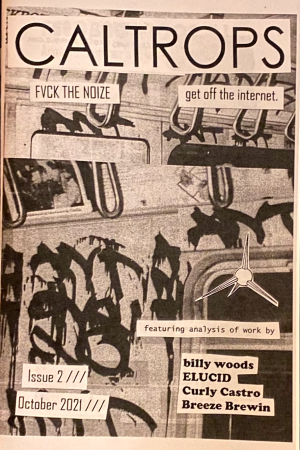
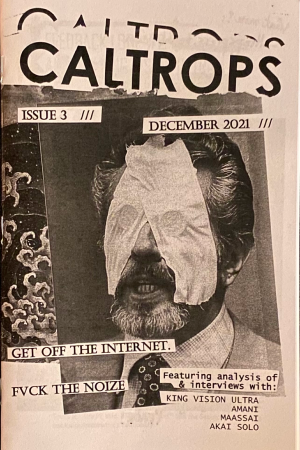
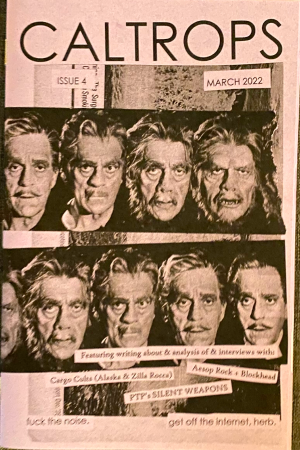

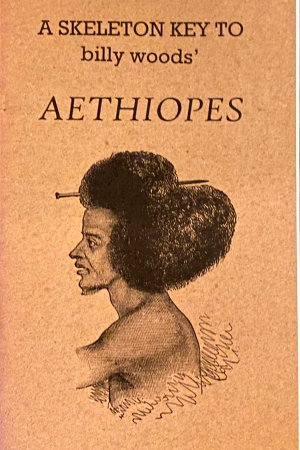

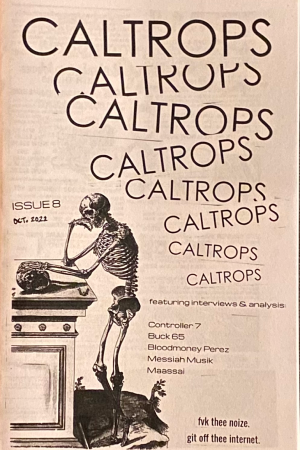
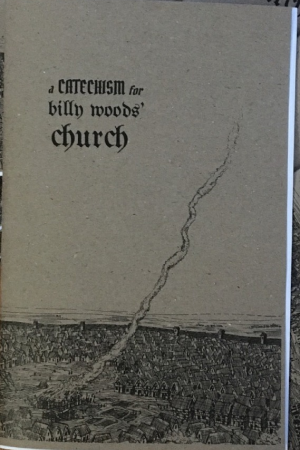
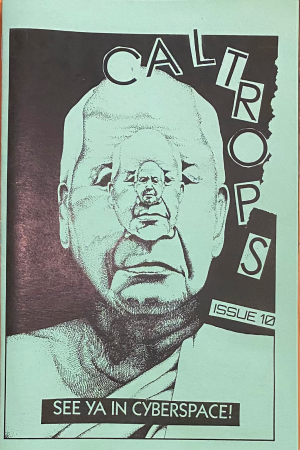
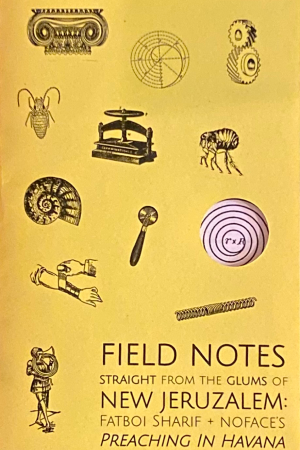

Featured image photo, display of Caltrops issues 1 to 5, Caltrops stickers, and “Codex Giga” by Joseph Rathgeber.
Photo of Joseph Rathgeber by Ananda Lima.
Humthrush.com will always be free to read and enjoy. If you like my work, leave a tip at Ko-fi.com/humthrush.
